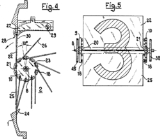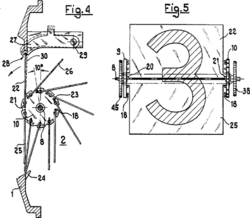
Analog clock with digital display
Encyclopedia

Clock
A clock is an instrument used to indicate, keep, and co-ordinate time. The word clock is derived ultimately from the Celtic words clagan and clocca meaning "bell". A silent instrument missing such a mechanism has traditionally been known as a timepiece...
which displays information in a digital
Digital
A digital system is a data technology that uses discrete values. By contrast, non-digital systems use a continuous range of values to represent information...
format on a split flap display, but actually keeps track of the time in an analog fashion.
Method of operation
An electric motorElectric motor
An electric motor converts electrical energy into mechanical energy.Most electric motors operate through the interaction of magnetic fields and current-carrying conductors to generate force...
(often synchronous
Synchronous motor
A synchronous electric motor is an AC motor distinguished by a rotor spinning with coils passing magnets at the same rate as the power supply frequency and resulting rotating magnetic field which drives it....
, if directly connected to the AC line) turns two sets of wheels continuously via a reduction gear train: the faster at a rate of 1 revolution per hour, the slower at a rate of 1 revolution per 24 hours. The wheels move continuously, not in steps.
The faster wheel has connected to it a ring of 60 flat plastic "leaves". On the "leaves" are printed numerals so that, when a person holds two adjacent "leaves" apart like an open book, the two open "leaves" spell out a numeral, and flipping a "leaf" down increases the number shown by 1 unit. The "book" is opened vertically, and its pages form a ring. This ring is put into position and rotated so that one page falls each minute, showing a new number for the minutes. "Leaves" 45 through 59 have a small tooth on them. The purpose of this tooth is explained later.
The slower wheel has connected to it a similar ring of "leaves", only there are 48 "leaves" on this ring. These "leaves" have hour numbers printed on them. There are two of each hour, like this: 12am, 12am, 1am, 1am, 2am, 2am, ... 11pm, 11pm. One leaf falls each half-hour, at approximately 25 and 55 minutes after the hour. A different design features 60 "leaves" with the numbers 1 to 12 repeated in fives, each leaf falling after 12 minutes. The disadvantage of this is that there is no way to show "AM" or "PM" information.
The teeth on minute leaves 45-59 are used as follows: at 45 minutes after the hour, the tooth pushes a lever that protrudes into the hour wheel area. This lever will catch any falling hour leaf, so that it'll hold the current hour leaf in place until it is time for the new hour to start.
Daylight Saving Time

Daylight saving time
Daylight saving time —also summer time in several countries including in British English and European official terminology —is the practice of temporarily advancing clocks during the summertime so that afternoons have more daylight and mornings have less...
, or by stopping it for an hour. On Some newer clocks though, forward and backward time setting may be accomplished. GE
Gê
Gê are the people who spoke Ge languages of the northern South American Caribbean coast and Brazil. In Brazil the Gê were found in Rio de Janeiro, Minas Gerais, Bahia, Piaui, Mato Grosso, Goias, Tocantins, Maranhão, and as far south as Paraguay....
clocks sometimes had this feature.

